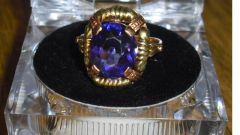There are many methods of determining the authenticity of amethyst. Go from simple to complex...
Visual inspection allows to reliably determine the presence of stones of uneven color. Smooth purple color, also change its color with the change of lighting, has a synthetic amethyst. Natural gem izvechen uniform.
Tactile contact (attach the stone to the inner side of the elbow) makes it possible to investigate the thermal conductivity of the sample. Natural amethyst long keeps cool. Its synthetic analogue is heated much faster.
Water test, for all its simplicity, very informative. Real amethyst in the water looks pale around the edges. Synthetic, being immersed in a container of water, looks exactly painted.
In UV light a natural gem looks uniformly pale. Synthetic stone under the rays of UV lighting reminds of a leopard...
Jewelry processing of the stone involves the abandonment of the girdle amethyst insert rough – if the stone is natural. Synthetic amethysts have polished the gap between the crown and the pavilion.
In the presence of the microscope (including portable) make sure you have many of the defects of natural stone. It is a synthetic analogue of any of the cavities of the tubules, cracks and other irregularities completely devoid.
Spectral and x-ray diffraction analysis – methods of the laboratory, accurate and cheap. However, they help to find out the truth in the most severe cases.
Visual inspection allows to reliably determine the presence of stones of uneven color. Smooth purple color, also change its color with the change of lighting, has a synthetic amethyst. Natural gem izvechen uniform.
Tactile contact (attach the stone to the inner side of the elbow) makes it possible to investigate the thermal conductivity of the sample. Natural amethyst long keeps cool. Its synthetic analogue is heated much faster.
Water test, for all its simplicity, very informative. Real amethyst in the water looks pale around the edges. Synthetic, being immersed in a container of water, looks exactly painted.
In UV light a natural gem looks uniformly pale. Synthetic stone under the rays of UV lighting reminds of a leopard...
Jewelry processing of the stone involves the abandonment of the girdle amethyst insert rough – if the stone is natural. Synthetic amethysts have polished the gap between the crown and the pavilion.
In the presence of the microscope (including portable) make sure you have many of the defects of natural stone. It is a synthetic analogue of any of the cavities of the tubules, cracks and other irregularities completely devoid.
Spectral and x-ray diffraction analysis – methods of the laboratory, accurate and cheap. However, they help to find out the truth in the most severe cases.



